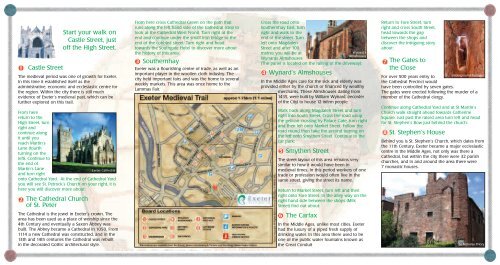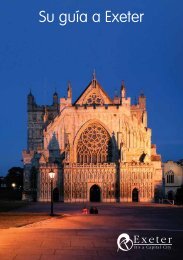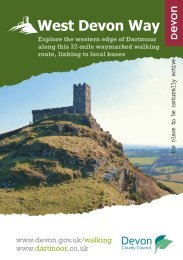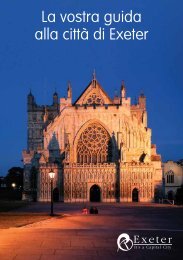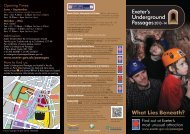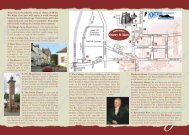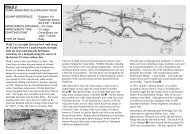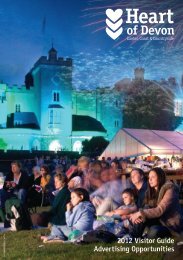Medieval Trail Leaflet - Exeter City Council
Medieval Trail Leaflet - Exeter City Council
Medieval Trail Leaflet - Exeter City Council
Create successful ePaper yourself
Turn your PDF publications into a flip-book with our unique Google optimized e-Paper software.
I<br />
Castle Street<br />
The medieval period was one of growth for <strong>Exeter</strong>.<br />
In this time it established itself as the<br />
administrative, economic and ecclesiastic centre for<br />
the region. Within the city there is still much<br />
evidence of <strong>Exeter</strong>’s medieval past, which can be<br />
further explored on this trail.<br />
From here<br />
return to the<br />
High Street, turn<br />
right and<br />
continue along<br />
it until you<br />
reach Martin’s<br />
Lane (fourth<br />
turning on the<br />
left). Continue to<br />
the end of<br />
Martin’s Lane<br />
<strong>Exeter</strong> Cathedral<br />
and turn right<br />
onto Cathedral Yard. At the end of Cathedral Yard<br />
you will see St. Petrock’s Church on your right, it is<br />
here you will discover more about:<br />
2<br />
The Cathedral Church<br />
of St. Peter<br />
Start your walk on<br />
Castle Street, just<br />
off the High Street.<br />
From here cross Cathedral Green on the path that<br />
runs along the left hand side of the Cathedral (stop to<br />
look at the Cathedral West Front). Turn right at the<br />
end and continue under the small iron bridge to the<br />
end of the cobbled street. Turn right and head<br />
towards the Southgate Hotel to discover more about<br />
the history of this area:<br />
3<br />
Southernhay<br />
<strong>Exeter</strong> was a flourishing centre of trade, as well as an<br />
important player in the woollen cloth industry. The<br />
city held important fairs and was the home to several<br />
weekly markets. This area was once home to the<br />
Lammas Fair.<br />
Cross the road onto<br />
Southernhay East, turn<br />
right and walk to the<br />
end of the street. Turn<br />
left onto Magdalen<br />
Street and after 100<br />
metres you will be at<br />
Wynards Almshouses<br />
(The panel is located on the railing of the driveway):<br />
4<br />
Wynard’s Almshouses<br />
In the Middle Ages care for the sick and elderly was<br />
provided either by the church or financed by wealthy<br />
merchants. These Almshouses dating from<br />
1435, were built by William Wynard, (recorder<br />
of the <strong>City</strong>) to house 12 infirm people.<br />
Walk back along Magdalen Street and turn<br />
right into South Street. Cross the road using<br />
the pelican crossing by Palace Gate, turn right<br />
and then left onto Market Street. Follow the<br />
road round then take the second turning on<br />
the left onto Smythen Street. Continue to the<br />
car park:<br />
5<br />
Smythen Street<br />
Wynard’s<br />
Almshouses<br />
The street layout of this area remains very<br />
similar to how it would have been in<br />
medieval times. In this period workers of one<br />
trade or profession would often live in the<br />
same street, giving the street its name.<br />
Return to Market Street, turn left and then<br />
right onto Fore Street. In the alley way on the<br />
right hand side between the shops (Milk<br />
Street) find out about:<br />
Return to Fore Street, turn<br />
right and cross South Street,<br />
head towards the gap<br />
between the shops and<br />
discover the intriguing story<br />
about:<br />
7<br />
The Gates to<br />
the Close<br />
For over 500 years entry to<br />
the Cathedral Precinct would<br />
have been controlled by seven gates.<br />
The gates were erected following the murder of a<br />
member of the Cathedral clergy.<br />
Continue along Cathedral Yard and at St Martin’s<br />
Church walk straight ahead towards Catherine<br />
Square. Just past the raised area turn left and head<br />
for St. Stephen’s Bow just behind the church:<br />
8<br />
St. Stephen’s House<br />
Underground Passages<br />
Behind you is St. Stephen’s Church, which dates from<br />
the 11th Century. <strong>Exeter</strong> became a major ecclesiastic<br />
centre in the Middle Ages, not only was there a<br />
Cathedral, but within the city there were 32 parish<br />
churches, and in and around the area there were<br />
7 monastic houses.<br />
The Cathedral is the jewel in <strong>Exeter</strong>’s crown. The<br />
area has been used as a place of worship since the<br />
4th Century and eventually a Saxon Abbey was<br />
built. The Abbey became a Cathedral in 1050. From<br />
1114 a new Cathedral was constructed, and in the<br />
13th and 14th centuries the Cathedral was rebuilt<br />
in the decorated Gothic architectural style.<br />
6<br />
The Carfax<br />
In the Middle Ages, unlike most cities, <strong>Exeter</strong><br />
had the luxury of a piped fresh supply of<br />
drinking water. In this area there used to be<br />
one of the public water fountains known as<br />
the Great Conduit<br />
St Nicholas Priory


